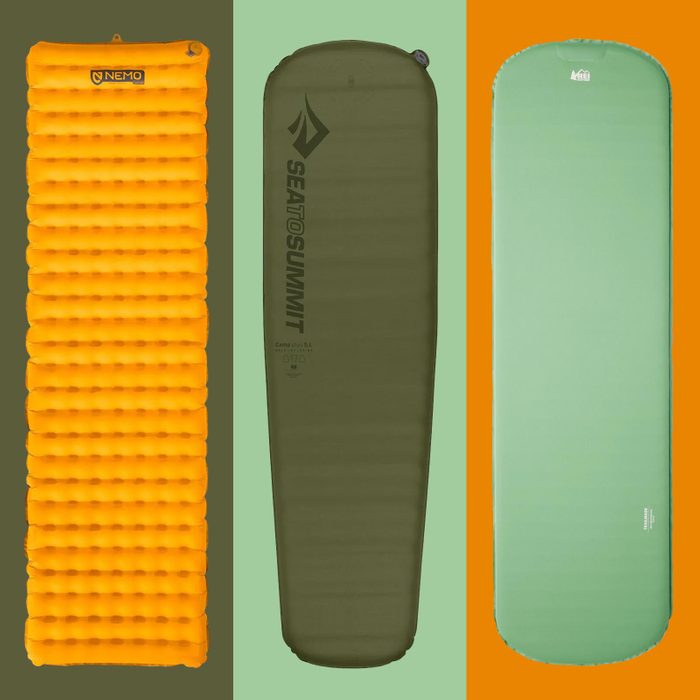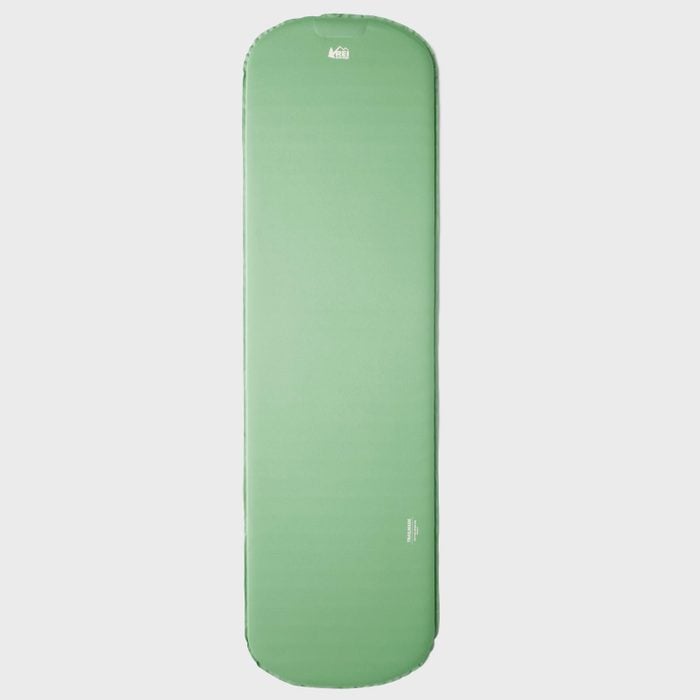 via merchant
via merchant
Best overall
REI Co-Op Trailmade Self-Inflating Sleeping Pad
The REI Co-Op Trailmade Self-Inflating Sleeping Pad is the sleeping pad I used for car camping across the U.S. For three months, I slept on this pad in the back of my car and on several tent camping trips. The upholstery on the sleeping pad is a stretchy, slightly plushy material, yet it’s easy to wipe off.
After three months of daily use, mine did suffer some stains, but probably nothing some carpet stain remover can’t take care of (I never tried, since I was on the road). It self-inflates with a double valve system (one for inflating, one for deflating). I tend to blow it up myself because it only takes a few breaths—no lightheadedness here.
With a thickness of 1.5 inches and an R-value rating of 5.5, REI recommends it for cold adventures. However, I had no problems sleeping comfortably on it in weather conditions ranging from 40 degrees to over 100. Additionally, I did have an issue with the pad staying inflated at one point.
I took it to a local REI, where they informed me that these Trailmade pads can sometimes deflate if dirt, saliva or other debris gets stuck in the inflation valve. They cleaned the valve out for me and the pad has been fine since! So, maybe don’t blow it up and let it self-inflate as intended.
Pros
- Easy setup and take-down
- Under $100
- Combo of foam and air cushion
- Self-inflating
- Stretchy, soft upholstery
- Compresses down for storage
- Comes with stuff sack
Cons
- Susceptible to stains
- If small debris gets stuck in the inflation valve, it may deflate overnight
- Only available at REI
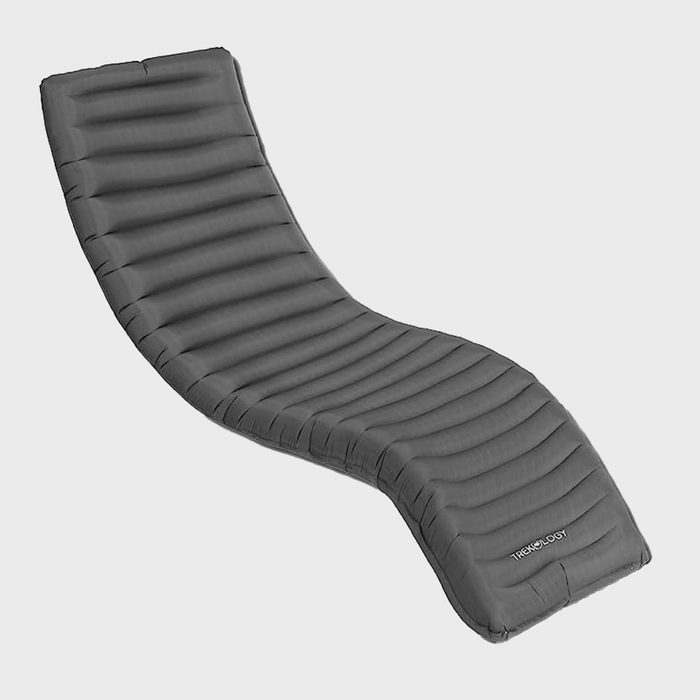 via merchant
via merchant
Best value
Trekology Ultralight Inflatable Sleeping Pad
On my aforementioned road trip, the Trekology sleeping pad was my backup pad. I used it when my Trailmade was deflating at night. I’ve also used it during many tent camping and backpacking trips since it’s much smaller when packed. Even so, it’s suitable for people up to six feet tall. The ample width means there’s room to turn around without falling off the mat.
It’s an extremely lightweight, easily inflatable, comfortable sleeping pad that performs amazingly in hot weather. This camping sleeping pad inflates four inches in thickness, but there isn’t any foam or insulation. For those reasons, it’s become my go-to mat for Florida camping. It provides more than enough cushion without increasing body temperature.
Pros
- Affordable price point
- Ultralight (weighs just 26.5 ounces)
- Packs down to 7 inches tall by 4 inches wide
- 4-inch thickness for plenty of cushion
- Great for warm weather camping
- Comes with a patch kit
- Available on Walmart and Amazon
Cons
- Not great for cold weather
- Hard to inflate by mouth; a bag inflator or pump is best (neither is included)
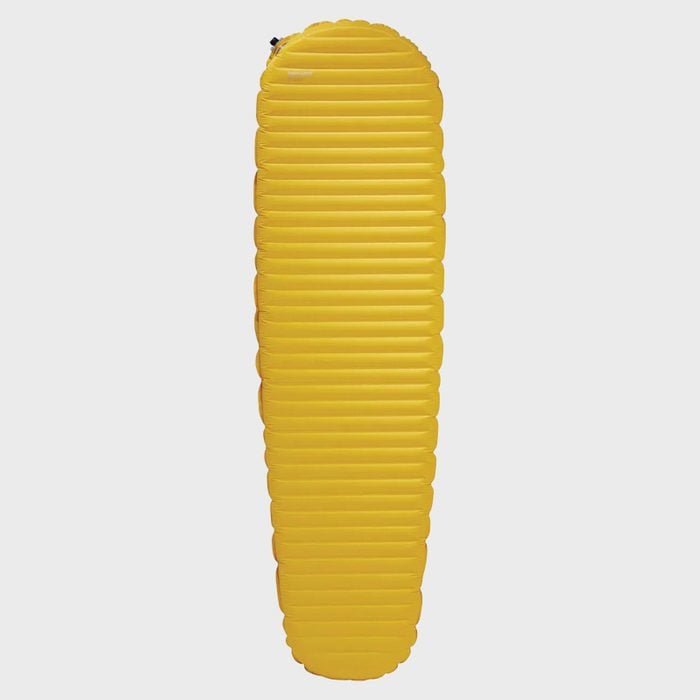 via merchant
via merchant
Best splurge
Therm-a-Rest NeoAir Xlite NXT Sleeping Pad
If you don’t mind spending a little more, I recommend the Therm-a-Rest NeoAir Xlite NXT Sleeping Pad. It’s worth the price because it’s warm, comfortable, lightweight and easy to use and pack. Pair it with a camping pillow for more comfiness.
This pad inflates via a pump sack, which is a small bag with a valve that replaces a hand pump or air compressor (two things you’re probably not taking backpacking). When inflated, it offers three inches of cushion and an R-value of 4.5, making it a good camping gear option for almost all weather conditions. Additionally, the mummy shape easily fits into mummy sleeping bags for additional warmth should you need it.
Pros
- 4.5 R-value makes it a good option for all-weather camping
- 3-inch thickness
- Pump sack (bag inflator) included
- Patch kit and stuff sack included
- Packs down small
- Plushy
- Multiple sizes available
- Available on Backcountry, REI and Amazon
Cons
- More expensive price
- Doesn’t self-inflate
- Makes slight crinkling noise
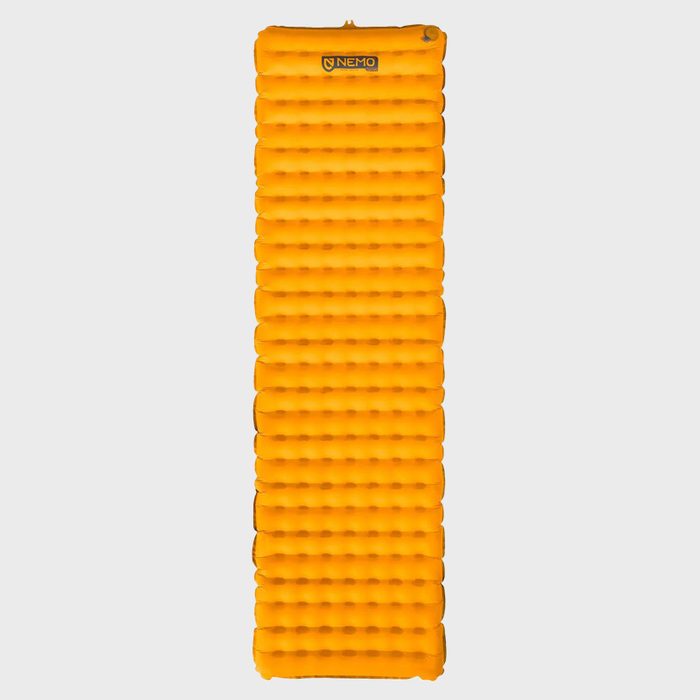 via merchant
via merchant
Best for backpacking
Nemo Tensor Insulated Sleeping Pad
This Nemo Tensor sleeping pad is available in various sizes and models, including an insulated or non-insulated version. It also comes in a mummy shape or regular shape. Enjoy three luxurious inches of cushion with small air chambers in a quilted pattern to reduce springiness and shifting.
Upholstered with 20D polyester, this pad is likely to make some crinkling sounds when moving, but that’s a tradeoff for durability. Softer fabrics don’t offer great longevity and are more prone to rips and tears, but another advantage to the 20D polyester is its weight. This sleeping pad ranges from less than 13 ounces up to 1.5 pounds for the largest insulated option, which is why it’s great for backpacking.
Non-insulated versions have an R-value of 2.5 while the insulated versions have an R-value of 4.2. The former is best for warm-weather camping while the latter will keep you warm during fall and spring with a good sleeping bag.
Pros
- Weighs as little as 13 ounces
- Lifetime warranty
- 3-inch thick cushion
- Smaller air chambers reduce shifting
- Customizable to work with the rest of your sleep system
- Durable polyester construction
- Available on Backcountry, Nemo, REI and Amazon
Cons
- May not be warm enough for cold winter camping
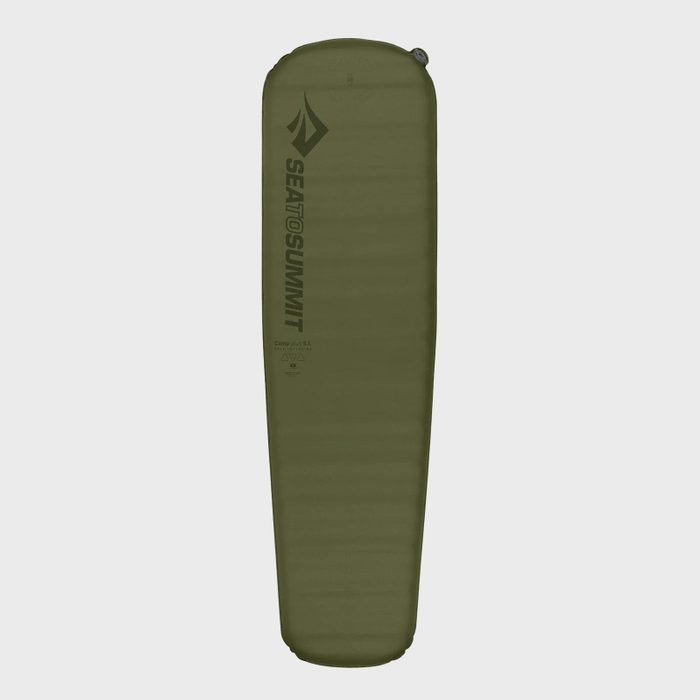 via merchant
via merchant
Best self-inflating
Sea to Summit Camp Plus Self-Inflating Sleeping Mat
Looking to take the work out of setting up camp? I don’t blame you. The more time saved during camp setup, the more time for adventuring and sitting around the campfire! The Camp Plus Self-Inflating Sleeping Mat is a time-saver in many regards: Not only does it have a set-it-and-forget-it inflation function, but it’s also easy to pack into the included stuff sack, making both setup and take-down a breeze.
Whichever size option you go for, enjoy a plush 3-inch lift from the ground for comfort, an R-value of 4.3 for ample warmth in almost all weather and very durable 75D polyester for defense against punctures and tears. If you prioritize comfort and convenience over weight, the Sea to Summit pad is a good option. Here’s where to find discounted camping gear too.
Pros
- Easy to inflate and deflate
- Available in four size/shape options
- Packed weight of 1.5 pounds to 3 pounds
- Stuff sack included
- Costs under $100
- Durable construction
- Available on Sea to Summit, REI and Amazon
Cons
- A bit bulky and heavy for backpacking
- Not all options available at all retailers
What to consider when buying the best camping sleeping pad
Whether you camp with family or a furry friend, here is a buyer’s guide on what to look for while shopping for the best camping sleeping pad.
Generally, sleeping pads range from 1 to 5 inches in thickness. Sleeping pads can be self-inflating, or they might require use of a pump sack, hand pump or air compressor. Deflation is usually as easy as opening the deflation valve, but read customer reviews to see how easy it is to get the air fully out.
Pack size and weight are important if planning to go backpacking with the sleeping pad. Light weights and small sizes are best for backpacking but don’t matter as much for drive-up camping. The inflated dimensions represent the sleeping surface size. Check this spec to make sure the pad is roomy enough.
Furthermore, look for helpful included items like a stuff sack, compression cords, a pump sack and a patch kit. Additionally, don’t forget about the R-value: the higher the R-value, the more warmth the pad offers. Lastly, most sleeping pads are upholstered with some sort of polyester fabric for durability. Look for 20D to 90D polyester; the higher the number, the tougher the fabric.
Types of camping sleeping pads
As you shop, it’ll help to get familiar with the different types of camping sleeping pads:
-
Air: The most lightweight option, air sleeping pads vary greatly in terms of comfort and durability. They are best for backpacking but great for drive-up camping too. You’ll find many options in terms of weight, size, comfort and durability.
-
Foam: Foam-only sleeping pads don’t require inflation. They are generally very comfortable but can compress while sleeping and tend to be quite bulky and heavy when packed.
-
Self-inflating: Usually, this type of sleeping pad contains a mix of air and foam for cushioning. They inflate themselves when the inflation valve is left open. There are a wide range of costs, comfort levels and size/weight combinations in this category.
How we found the best camping sleeping pad
As shopping experts, our only job is to help you find a winning product. We start with the research and reporting basics—what products are made of, what they look like and how much they cost—to ensure that we’re only recommending the buys that are worth your time and money. Then, we research the features that speak to the product’s quality, taking advice from industry insiders and subject matter experts on what makes a product a smart value (or worthy of a splurge). Finally, we do the work of combing through user reviews to see how real people interact with the product, and if it stands up to the test.
FAQ
What is the best sleeping pad thickness?
The best sleeping pad thickness really comes down to personal preference, but I recommend looking at 1.5 inches at a minimum. For thinner sleeping pads, a combination of foam and air is typically best. With thicker pads, you can get away with just air as a cushion. Camping sleeping pads can get as thick as 5 inches, but 3 inches seems to be the sweet spot for most people to balance comfort and weight.
Are camping sleeping pads worth it?
Absolutely! This is one of the best investments and camping hacks to add to your gear setup. Nothing is fun when you’re running low on sleep, and a sleeping pad is the best way to ensure you get a good night’s rest at camp.
How do you get a good night’s sleep while camping?
I recommend investing in a good sleep system, which includes a sleeping bag, sleeping pad, camp pillow and potentially a camping cot depending on what type of camping. Other than having a good sleep system, increase your chances of a good night’s sleep by choosing a level campsite, using a battery-powered fan in hot weather and fully extinguishing campfires a while before bed so as not to inhale a ton of smoke.

